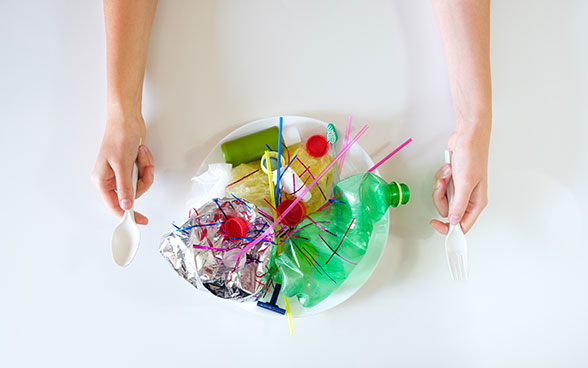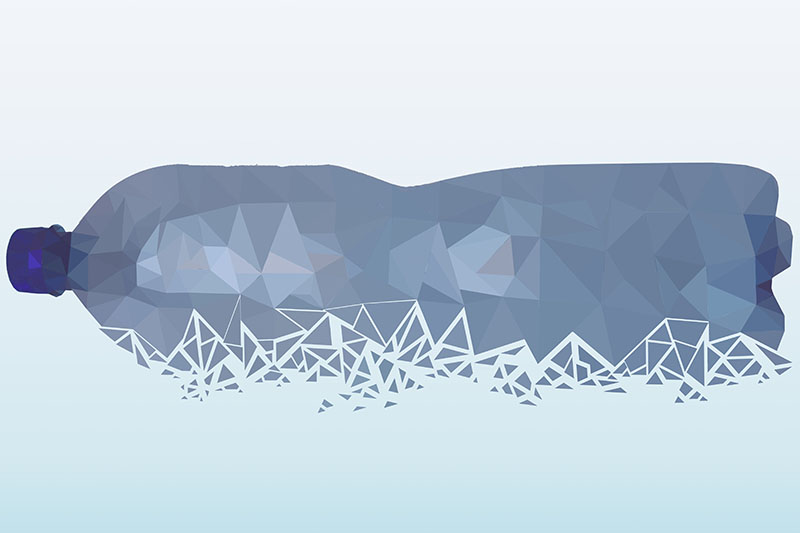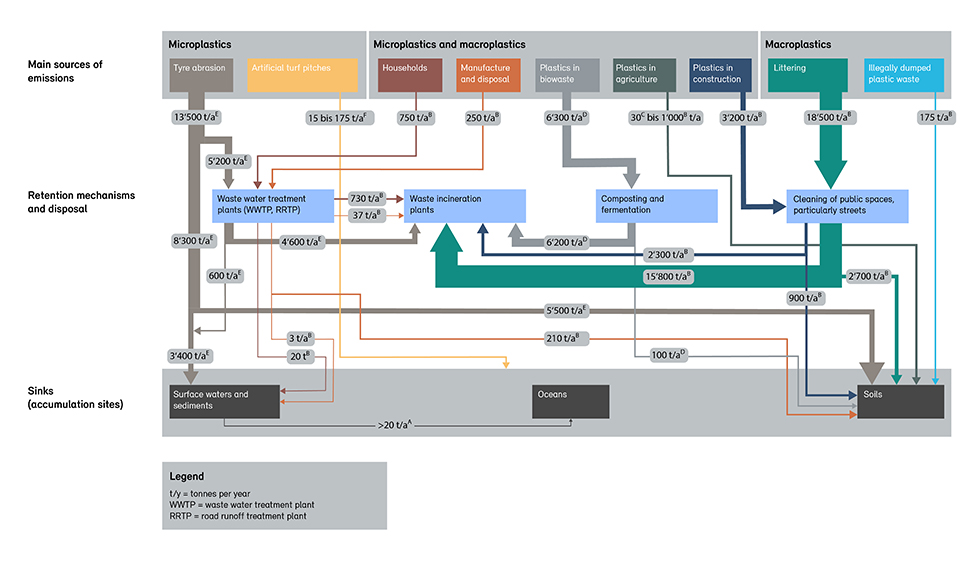Plastics have no place in the environment. Nevertheless, around 14,000 tonnes of plastics end up in Switzerland’s soil and waters every year – primarily due to the abrasion and decomposition of plastic products and improper disposal of plastic waste. Plastics then accumulate in the environment because they only degrade very slowly, which is why the amount released into the environment must be reduced to the absolute minimum in order to avoid damage as far as possible.

- The environmental impact of a versatile material
- Macroplastics and microplastics
- How plastics are released into the environment
- Need for research into plastics in the environment
- Summary of current knowledge for the general public
- Minimising plastic pollution in the environment
- International action
- The European stance: The EU Plastics Strategy
The environmental impact of a versatile material
One million tonnes of plastics are used every year in Switzerland. They are used both in durable products such as window frames and car body parts, and in short-lived products such as packaging and disposable tableware. Every year, around 790,000 tonnes of plastics are thermally processed in waste incineration plants and cement works or are fed back into the material cycle through recycling and reuse.
As a result of their versatility and durability, plastics are found everywhere in the world: in oceans, Arctic ice, mountains, soils, rivers, lakes, sediments, air and in the digestive tract of living organisms. What is more, there are numerous different types of plastic with a wide variety of additives.
It is important to distinguish between macroplastics and microplastics in order to understand the extent of environmental pollution caused by this material. How they enter the environment, as well as the possible effects on living organisms, varies widely depending on the size of the plastic particles. This distinction allows us to decide which measures are best for reducing plastic waste.
Macroplastics and microplastics
Macroplastics are plastic parts larger than five millimetres and plastic waste, while microplastics are smaller than five millimetres and barely visible. Microplastics can be further subdivided into primary and secondary microplastics.
Primary microplastics are plastic particles that are deliberately manufactured as such and added to products (e.g. artificial turf infill, fertilisers, plant protection products, cosmetics, household and industrial cleaners, and paints and varnishes).
Secondary microplastics are generated during the use and disposal of plastic products (e.g. abrasion from car tyres, fibres shed from washing synthetic textiles, and shredding processes) or during the decomposition of macroplastics into microplastics.
How plastics are released into the environment
Based on the data available from studies for Switzerland, the FOEN estimates that around 14,000 tonnes of macroplastics and microplastics end up in Swiss soil, surface waters and sediment every year. The majority of these plastics enter the environment through tyre abrasion (around 8,900 tonnes) and littering (around 2,700 tonnes), as well as from numerous other sources. The material flow diagram below shows the quantities of the largest sources of these plastics, mechanisms for their retention and disposal, and plastic sinks (i.e. accumulation sites) in the environment.
Sources for the material flow diagram
A The FOEN's estimate of the amount of microplastics entering the oceans via Swiss watercourses is based on the following study:
B
C
D Kawecki, Delphine; Livnat Goldberg, and Bernd Nowack (2021). Material flow analysis of plastic in organic waste in Switzerland. Soil Use and Management.
E Based on the following studies:
Steiner, Michele (2020). Mikroplastik: Eintrag von Reifenabrieb in Oberflächengewässer. (PDF, 1 MB, 21.06.2020)Commissioned by the FOEN (in German)
Steiner, Michele (2022). Priorisierung von Massnahmen zur Reduktion des Eintrags von Reifenabrieb in Oberflächengewässer. Commissioned by the FOEN. Report not yet published.
F Patrick, Michael, Ann-Kathrin Stalder, Cengiz Akandil, Patricia Meier, and Michael Burkhardt (2022). Erhebung von Kunststoffrasenflächen und Mikroplastik in der Schweiz (KUNST). Commissioned by the FOEN. Report not yet published.
Additional information
- Knowledge about the emission and release of plastics into the Swiss environment is constantly being improved in the course of research work. According to current findings, an additional 500 tonnes of plastic waste can be added to the above material flow diagram (see Liu, Zipeng and Bernd Nowack (2022). Probabilistic material flow analysis and emissions modeling for five commodity plastics (PUR, ABS, PA, PC, and PMMA) as macroplastics and microplastics. Resources, Conservation and Recycling). The types of plastics considered in the Liu and Nowack study (2022) are not shown in the material flow diagram because they cannot be clearly assigned to individual sources.
- Tyre abrasion: Tyre abrasion is a combination of three different groups of substances (plastics, fillers and inorganic substances), which is why microplastics account for just 60% of tyre abrasion particles.
- Households: Sources include fibres shed from washing synthetic textiles, microplastics in cosmetics, and plastics incorrectly disposed of via the toilet such as hygiene products.
Main emission sources (see top row of boxes in the material flow diagram)
Macroplastics are released into the environment primarily through plastic waste not being correctly disposed of (e.g. littering, plastics in green waste collection). The majority of microplastics are released as secondary microplastics through the abrasion and decomposition of plastic products (e.g. tyre abrasion). The amount of microplastics intentionally added to products (e.g. exfoliants in cosmetics) or released into waste water through fibres shed from synthetic textiles when washed is small compared to the total amount of microplastics released into the environment. However, large amounts of these plastics are found in surface waters.
Retention mechanisms and disposal (see middle row of boxes in the material flow diagram)
A number of established measures, such as waste water treatment, waste disposal and street cleaning, significantly reduce plastics being released into the environment. Swiss residential waste and waste water management sectors and local authorities substantially contribute to ensuring that plastics do not end up in the environment. However, not all emissions can be fully captured by such treatment measures and retention mechanisms. Litter and tyre abrasion, for example, enter waterbodies and soils via rainwater surface runoff or through airborne transmission.
Sinks (see bottom row of boxes in the material flow diagram)
Plastics released into the environment remain long-term in sinks, i.e. in the sediments of waterbodies and in soils. According to current knowledge, in Switzerland larger amounts of plastics are released onto and into the soil than into surface waters. Oceans polluted with microplastics and macroplastics is an additional problem internationally.
Need for research into plastics in the environment
Due to the complexity of the material flows of plastics in the environment, there are various areas in which there is an insufficient level of knowledge. Extensive research activities in the following areas are still needed to close the knowledge gap:
- Acquiring in-depth knowledge about the release of plastics in the environment
- Knowledge about the location, behaviour and degradation of plastics in the environment
- Information on the effects of plastics (including additives) on living organisms and ecosystems.
Although some information exists in all three areas, it is marred by uncertainties because the differing methodologies and units used make the data difficult to compare and interpret. A practical measurement methodology still needs to be developed for very small particles (e.g. tyre abrasion), as they cannot be detected with methods currently in use.
Summary of current knowledge for the general public
The Plastics in the Environment report, in response to the postulates Thorens Goumaz (18.3196), Munz (18.3496), Flach (19.3818) and the CVP Group (19.4355), gives an overview of the subject (as of summer 2022). The first part of the report describes the plastics life cycle from manufacture to disposal. It then goes on to present the most common sources of plastics and how they enter the environment, plastics sinks, and the effects on the environment and health. The second part of the report highlights ongoing and previously implemented measures, as well as potential for improvements.
The FOEN has summarised current knowledge and core messages for the general public in ten factsheets on the main topics of the Plastics in the Environment report (as of spring 2020). The factsheets will be updated soon.
Plastics in the environment: Plastics in biowaste collections (PDF, 822 kB, 12.05.2020)Factsheet No 9
Minimising plastic pollution in the environment
Plastics do not decompose in the environment, or if they do, only over a very long period of time – sometimes as much as several hundred years. They then accumulate in the environment, which is why their release must be reduced to the absolute minimum in order to avoid damage as far as possible.

© BAFU
The debate on urgent measures to reduce the environmental impact of plastics is in full swing in Switzerland, as it is in other countries. This is demonstrated by the significant number of political initiatives on the subject that are currently being dealt with in Parliament and the public administration. The Plastics in the Environment report, in response to the postulates Thorens Goumaz (18.3196), Munz (18.3496), Flach (19.3818) and the CVP Group (19.4355), sets out the potential for improvements. With the adopted motion 18.3712 “Less plastic waste in waters and soil", submitted by the National Council's Committee for the Environment, Spatial Planning and Energy (ESPEC-N), Parliament is demanding that the Confederation, together with the industries concerned, should examine and take measures to fully and effectively counteract environmental pollution caused by plastics, including its main sources of emission.
International action
A significant amount of environmental impact caused by plastics arises from primary production, which largely takes place abroad. This means that global problems can only be solved through joint action, which is why the FOEN also advocates the sustainable use of plastics at international level and participates in international bodies.
In March 2022 the UN Environment Assembly (UNEA) decided to start negotiations on a legally binding agreement on plastics. Negotiations will start at the end of 2022 and are to lead to a Plastics Convention in 2024. The aim is to reduce the environmental impact of plastics throughout their full life cycle. Switzerland is in favour of an ambitious agreement and is a member of the High Ambition Coalition (HAC), a group of countries committed to ensuring that the Plastics Convention results in the elimination of plastics from the environment by 2040.
Further information on the Plastics Convention: Intergovernmental negotiating committee on Plastic Pollution and the High Ambition Coalition to End Plastic Pollution.
In addition, Switzerland is a party to the Basel Convention on the Control of Transboundary Movements of Hazardous Wastes and their Disposal (in German, French and Italian). At the Conference of the Parties to the Basel Convention in May 2019, the Swiss delegation actively endorsed making mixed plastic waste subject to control from the beginning of 2021. This means that all countries concerned (i.e. exporting, transit and importing countries) must give their prior consent to planned transboundary movements. Further information on the implementation of the new regulations in Switzerland: Transboundary movement of waste
A public-private partnership on plastic waste was established under the Basel Convention (Plastic Waste Partnership). It aims to mobilise resources, interests and expertise from industry, government, academia and civil society in order to improve the management of plastic waste and, where possible, prevent it being generated.
The European stance: The EU Plastics Strategy
In 2015, the EU published the first Circular Economy Action Plan, in which plastics were one of five priority areas. This was followed in 2018 by the European Strategy for Plastics in the Circular Economy (EU Plastics Strategy), which outlines measures to reduce Europe's dependence on imported fossil resources and cut CO2 emissions. One of the overarching goals of this strategy is to ensure that all plastic packaging on the EU market is either reusable or recyclable in a cost-effective manner by 2030.
In 2019, the EU Plastics Strategy was fleshed out in the Directive on the reduction of the impact of certain plastic products on the environment (Single-Use Plastics Directive, Directive (EU) 2019/904). This requires member states to take a series of measures aimed at reducing single-use plastic products. The EU directive introduces bans on a number of products, including oxo-degradable plastics, drinking straws and disposable plastic cutlery. However, it also provides for awareness-raising measures, requirements for products to be labelled with a new logo indicating the proper method of disposal, greater producer responsibility, and the reduction of certain single-use plastic products such as beverage cups. EU member states must incorporate appropriate measures in their national legislation over the next few years. Switzerland is not required to implement the Single-Use Plastic Directive; however, the FOEN is monitoring the EU's work and continuously assesses what changes might be made to Swiss legislation.
In 2020, the EU published a new Circular Economy Action Plan, which further develops the measures adopted in its plastics strategy. It focuses on proposals for mandatory requirements on recycled plastic content and for the creation of a clear policy framework for labelling biodegradable and bio-based plastics. The action plan also seeks to bolster implementation of the Single-Use Plastics Directive and tackle the occurrence of microplastics in the environment (for example by restricting microplastics intentionally added to products such as in cosmetics).
At European level, Switzerland's representatives also participate in various working groups focused on plastics such as the Plastics Interest Group of the Network of the Heads of European Environmental Protection Agencies (EPA-Network).
Further information on the work of the EU: Plastics
Further informations
News
Links
Documents
Study «IDHEAP: Comparing European and Swiss Strategies for the Regulation of Plastics» (PDF, 3 MB, 30.06.2021)Commissioned by the FOEN
Plastik in der Schweizer Umwelt (PDF, 1 MB, 15.04.2020)Studie im Auftrag des BAFU
Study «Mikroplastik: Eintrag von Reifenabrieb in Oberflächengewässer» (PDF, 1 MB, 21.06.2020)Commissioned by the FOEN (in German)
Study «The Identity of Oxo-Degradable Plastics and their Use in Switzerland» (PDF, 2 MB, 31.03.2020)Commissioned by the FOEN
Technical article «Modellierung von Plastik in der Umwelt» (PDF, 1 MB, 05.05.2020)Article on a study commissioned by the FOEN (in German including summary in French)
Last modification 23.09.2022







